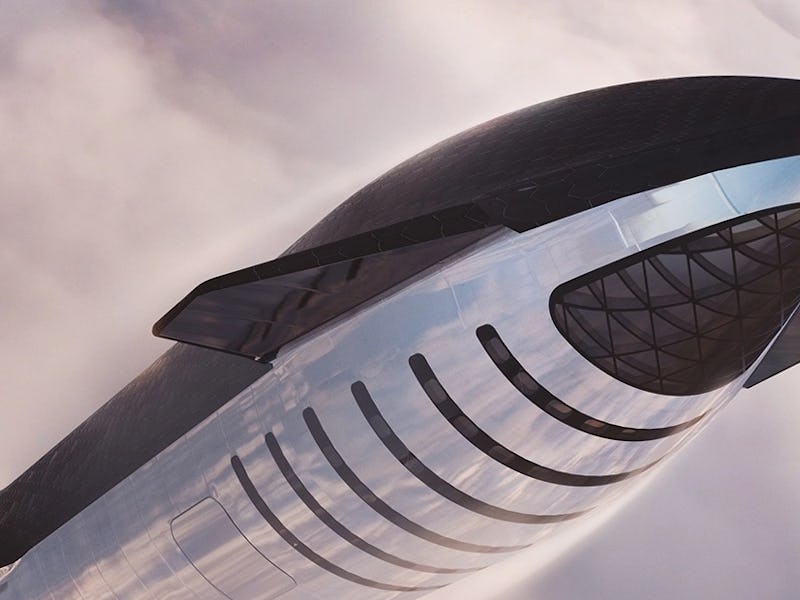SpaceX Starship: Incredible render shows how Mars rocket design is evolving
SpaceX's under-development rocket is set to soar, and a new render shows how the ship will look with the booster attached.

The Starship, SpaceX’s under-development rocket, looks set to stun.
On Tuesday, Supercluster shared a concept render of the Starship soaring past the clouds, supported by the giant Super Heavy booster. The image, which the outlet says comes courtesy of SpaceX, was spotted at the Satellite 2021 industry conference this week in National Harbor, Maryland.
The image shows one of SpaceX’s most ambitious projects in incredible new detail. CEO Elon Musk first unveiled the Starship’s predecessor in 2017, intending to take over existing Falcon 9 launches while enabling more ambitious missions. These include a city on Mars by 2050, enabled by the ship’s fully reusable design and ability to transport 100 people at a time.
The changes show how SpaceX’s design is evolving, as Musk himself said in March 2020. Musk regularly shares updates via Twitter on tweaks like the number of legs and number of engines. As the company gears up to host the rocket’s first orbital flight sometime within the next four months, the render recalls how the Starship that flies to Mars could look ever more different than previous iterations.
Want to find out more about SpaceX’s plans for Starship? Subscribe to MUSK READS+ for exclusive interviews and analysis about spaceflight, electric cars, and more.
Supercluster chief of content Robin Seemangal shared a photo on his Twitter page of the render on a poster. The photo suggests the poster is located outside the Chesapeake conference rooms.
Robin Seemangal's photo of the new render.
The full-size rendering is here:
The rendering bears similarities to the one currently seen on SpaceX’s website:
The Starship render seen on SpaceX's website.
The two images reveal several changes. The top window is now smaller, leaving more stainless steel toward the nose. This window has been featured in previous renders, showing concerts in zero gravity.
Musk’s post showing a concert in zero gravity.
The new render also shows the grid fins extended out. These, as Musk explained in December 2020, will enable SpaceX to catch the Super Heavy booster as it returns to Earth using the “Mechazilla” tower.
However, the latest rendering is unlikely to show the final design. In August, Musk claimed that the forward flaps seen at the ship's top would be positioned further toward the windows. This will better enable the ship to complete the belly flop maneuver as it lands.
SpaceX did not respond to Inverse’s request for comment.
The Inverse analysis — SpaceX’s rendering is impressive. Perhaps most interesting is that it appeared at the Satellite 2021 conference.
The company sent three representatives to the event, including president Gwynne Shotwell. These appearances largely focused on Starlink, the company’s under-development satellite internet service. During the conference, SpaceX chief financial officer Bret Johnson confirmed that the company plans to launch satellites to cover polar latitudes in the “next couple of days.”
But the Starship’s appearance at the show was not irrelevant. If SpaceX plans to use the ship to cover existing Falcon 9 launches, it could mean that the company can launch far more than the 60 Starlink satellites packed with every Falcon 9 rocket. That could mean SpaceX builds out its constellation faster.
As the orbital launch approaches, it’s a reminder of how the Starship will affect practically every aspect of the business and accelerate its plans.
SPACEX STARSHIP ORBITAL FLIGHT: HOW DID WE GET HERE?
- November 2018 — BFR, first announced in September 2017, gets renamed Starship
- December 2018 — Musk confirms the new ship has switched to stainless steel
- January 2019 — Shortened “Starhopper” prototype unveiled, and Musk explains the switch to steel
- February 2019 — Raptor engine beats a long-standing rocket record.
- April 2019 — Starhopper completes a tethered “hop”
- July 2019 — Starhopper launches 20 meters (67 feet)
- August 2019 — Starhopper launches 150 meters (500 feet)
- September 2019 — Starship Mk.1 full-size prototype unveiled
- May 2020 — Starship SN4 full-size prototype completes a static test fire
- August 2020 — SN5 launches 150 meters (500 feet)
- October 2020 — SN8 completes the first triple-Raptor static fire
- December 2020 — SN8 launches 12.5 kilometers (41,000 feet) and crashes into the ground
- February 2021 — SN9 launches 10 kilometers (33,000 feet) and crashes into the ground
- March 2021 — SN10 launches 10 kilometers (33,000 feet), lands, and explodes eight minutes later. That same month, SN11 launches 10 kilometers (33,000 feet) and hits the ground in several pieces.
- May 2021 — SN15 launches 10 kilometers (33,000 feet) and lands without a hitch, except for a small fire at the base
SUBSCRIBE TO MUSK READS+, A PREMIUM NEWSLETTER THAT COVERS THE WORLDS OF ELON MUSK, SPACEX, TESLA, AND EVERYTHING BETWEEN.